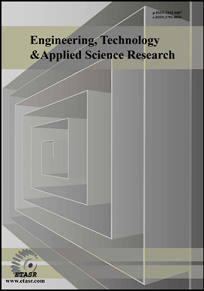The Impact of Recycled Material Reinforcement on the Performance of Mortars
Received: 29 July 2024 | Revised: 20 August 2024 | Accepted: 24 August 2024 | Online: 8 September 2024
Corresponding author: Enea Mustafaraj
Abstract
This study investigates the use of recycled fibers as reinforcement in structural mortar to enhance its mechanical and physical properties. Polypropylene from onion bags, cotton from jeans, mesh fibers from date palms, and steel wool from dish sponges of various concentrations were tested as recycled materials. Experimental tests were performed on 63 mortar prisms, each measuring 40 mm × 40 mm × 160 mm. Fiber concentrations varied for each material type. Reinforced fiber mortar improvement was compared to control specimens in terms of flexural and compressive strength and failure mode. The determined optimal percentages were 0.2% polypropylene, 1.6% jeans, 2% date palm mesh, and 1% steel wool fibers. SEM analysis was also performed to explore the microstructure and bonding ability of the fibers within the mortar matrix.
Keywords:
fiber-reinforced mortar, flexrual strength, compressive strength, sustainability, SEM analysis, recycled fibersDownloads
References
S. O. Franklin and K. S. Mronga, "Comparative study of mechanical properties of steel wool and polypropylene fibre reinforced cement mortar composites," International Research Journal of Engineering and Technology, vol. 8, no. 12, pp. 1609–1614, 2021.
M. M. Sazzad, N. Sudipta, and S. Poly, "Strength Behavior of Cement Mortar Reinforced with Steel Fibers at Elevated Temperature," Journal of Civil and Construction Engineering, vol. 6, no. 1, pp. 19–26, Jan. 2020.
P. I. Abdulrahman and D. K. Bzeni, "Bond strength evaluation of polymer modified cement mortar incorporated with polypropylene fibers," Case Studies in Construction Materials, vol. 17, Dec. 2022, Art. no. e01387.
H. Wang, W. Ni, and K. Yuan, "Mechanical properties, microstructural evolution, and environmental impacts of recycled polypropylene fiber stabilized loess," Construction and Building Materials, vol. 400, Oct. 2023, Art. no. 132850.
W. Tang, R. Monaghan, and U. Sajjad, "Investigation of Physical and Mechanical Properties of Cement Mortar Incorporating Waste Cotton Fibres," Sustainability, vol. 15, no. 11, Jan. 2023, Art. no. 8779.
U. Gunathilaka, C. Jayathilaka, and H. M. C. Somarathna, "Feasibility of Cement Mortar System with Textile Waste," in International Conference on Engineering - 2022, Aug. 2022.
H. Khelifa et al., "Mechanical characterization of mortar reinforced by date palm mesh fibers: Experimental and statistical analysis," Construction and Building Materials, vol. 300, Sep. 2021, Art. no. 124067.
S. Vantadori, A. Carpinteri, and A. Zanichelli, "Lightweight construction materials: Mortar reinforced with date-palm mesh fibres," Theoretical and Applied Fracture Mechanics, vol. 100, pp. 39–45, Apr. 2019.
N. G. Ozerkan, B. Ahsan, S. Mansour, and S. R. Iyengar, "Mechanical performance and durability of treated palm fiber reinforced mortars," International Journal of Sustainable Built Environment, vol. 2, no. 2, pp. 131–142, Dec. 2013.
F. Althoey et al., "Behavior of Concrete Reinforced with Date Palm Fibers," Materials, vol. 15, no. 22, Jan. 2022, Art. no. 7923.
M. Sh. Al-Otaibi, O. Y. Alothman, M. M. Alrashed, A. Anis, J. Naveen, and M. Jawaid, "Characterization of Date Palm Fiber-Reinforced Different Polypropylene Matrices," Polymers, vol. 12, no. 3, Mar. 2020, Art. no. 597.
Y. E. Ibrahim, M. Adamu, M. L. Marouf, O. S. Ahmed, Q. A. Drmosh, and M. A. Malik, "Mechanical Performance of Date-Palm-Fiber-Reinforced Concrete Containing Silica Fume," Buildings, vol. 12, no. 10, Oct. 2022, Art. no. 1642.
A. Kriker, G. Debicki, A. Bali, M. M. Khenfer, and M. Chabannet, "Mechanical properties of date palm fibres and concrete reinforced with date palm fibres in hot-dry climate," Cement and Concrete Composites, vol. 27, no. 5, pp. 554–564, May 2005.
"Kuwait Vision 2035 "New Kuwait." MOFA, https://www.mofa.gov.kw/en/pages/kuwait-vision-2035.
E. M. Ragab, T. M. Awwad, and N. Becheikh, "Thermal and Mechanical Properties Enhancement of Cement Mortar using Phosphogypsum Waste: Experimental and Modeling Study," Engineering, Technology & Applied Science Research, vol. 14, no. 2, pp. 13153–13159, Apr. 2024.
M. S. Amouri and N. M. Fawzi, "The Mechanical Properties of Fly Ash and Slag Geopolymer Mortar with Micro Steel Fibers," Engineering, Technology & Applied Science Research, vol. 12, no. 2, pp. 8463–8466, Apr. 2022.
ASTM C150/C150M-22(2022), Standard Specification for Portland Cement. West Conshohocken, PA, USA: ASTM International, 2022.
ASTM C33/C33M-18(2018), Standard Specification For Concrete Aggregates. West Conshohocken, PA, USA: ASTM International, 2018.
L. Kohan, L. S. Coelho, J. Baruque-Ramos, and H. Savastano Junior, "Cellulosic Fabric-Reinforced Cementitious Matrix (FRCM): Ligaments, Treatments, and Employment," Materials Circular Economy, vol. 4, no. 1, Jan. 2022, Art. no. 8.
N. Bahlouli et al., "Recycling effects on the rheological and thermomechanical properties of polypropylene-based composites," Materials & Design, vol. 33, pp. 451–458, Jan. 2012.
T. Thwe Win, P. Jongvivatsakul, T. Jirawattanasomkul, L. Prasittisopin, and S. Likitlersuang, "Use of polypropylene fibers extracted from recycled surgical face masks in cement mortar," Construction and Building Materials, vol. 391, Aug. 2023, Art. no. 131845.
BS EN 1015-11(2019), Methods of test for mortar for masonry. Determination of flexural and compressive strength of hardened mortar. London, UK: British Standards Institution, 2019.
Downloads
How to Cite
License
Copyright (c) 2024 Wahaj Alhabib, Jood Alhawal, Batlah AlRashidi, Shaikha AlAbdulqader, Zinab AlSayegh, Enea Mustafaraj

This work is licensed under a Creative Commons Attribution 4.0 International License.
Authors who publish with this journal agree to the following terms:
- Authors retain the copyright and grant the journal the right of first publication with the work simultaneously licensed under a Creative Commons Attribution License that allows others to share the work with an acknowledgement of the work's authorship and initial publication in this journal.
- Authors are able to enter into separate, additional contractual arrangements for the non-exclusive distribution of the journal's published version of the work (e.g., post it to an institutional repository or publish it in a book), with an acknowledgement of its initial publication in this journal.
- Authors are permitted and encouraged to post their work online (e.g., in institutional repositories or on their website) after its publication in ETASR with an acknowledgement of its initial publication in this journal.






